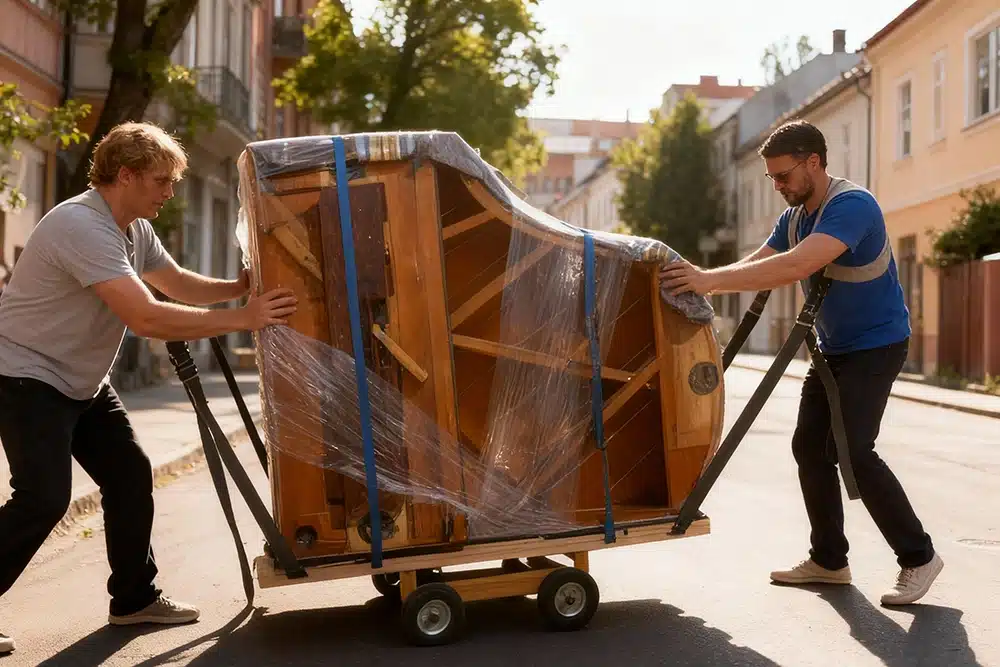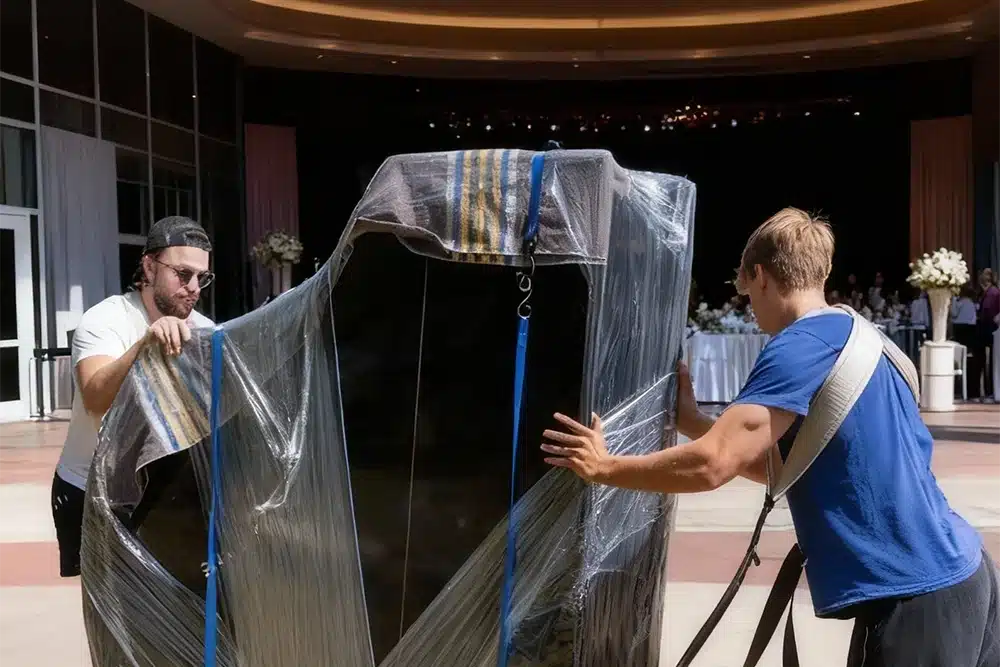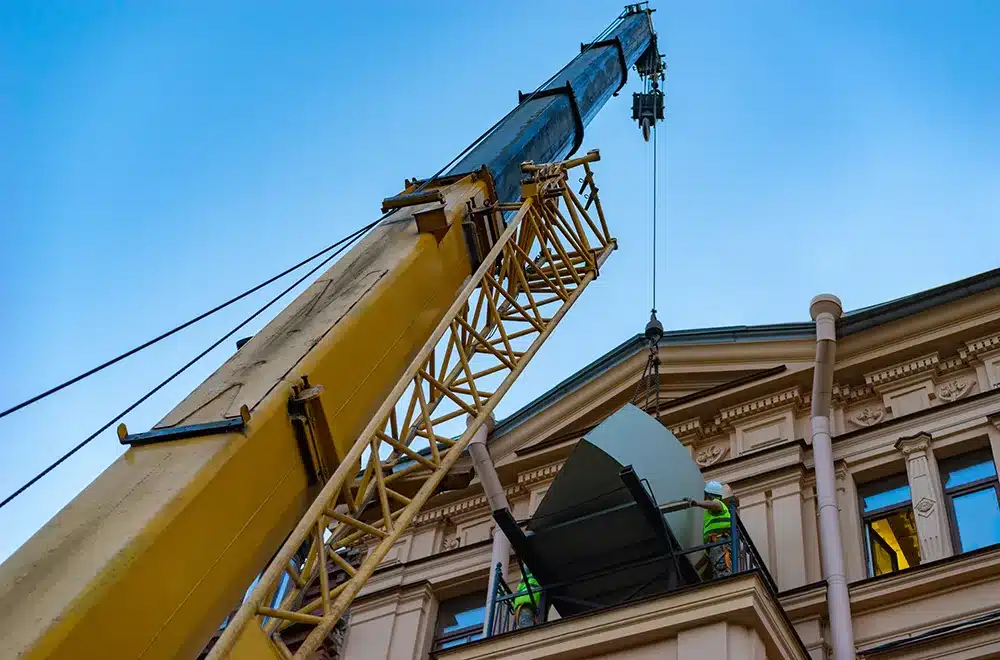What happens when your grand piano won’t fit through the door? For many Houston homeowners, this scenario is all too real. Whether it’s a concert grand on an upper floor, an antique upright in a historic home, or a baby grand that simply won’t angle through a narrow staircase, moving a piano can be much more complicated than sliding furniture onto a dolly. This is where professional piano movers step in. With the right training, specialized tools, and precision techniques, they handle the jobs that general movers can’t. From cranes to climate-controlled trucks, these experts know how to safeguard your instrument’s structure, soundboard, and finish while getting it safely to its new location. In this article, we’ll look at how professional piano movers use cranes and other heavy piano moving equipment, such as skid boards and hoisting systems, to keep your instrument protected, even in the most difficult moves.
Why Standard Moving Equipment Isn’t Enough for Pianos
Unlike a couch or table, a piano is not just heavy; it’s also fragile, intricate, and often irreplaceable. Pianos can weigh anywhere from 300 to over 1,000 pounds, yet their inner mechanics are so delicate that even a small jolt can disrupt tuning or damage the soundboard. Attempting to move one with only basic dollies, straps, and manpower is risky. Without proper balance, a piano can tip or sustain scratches, cracked legs, or internal damage. In some cases, the wrong move may even make the instrument unplayable. Beyond the piano itself, trying to move one without the right equipment also increases the risk of injury to both movers and homeowners.
That’s why general movers, no matter how skilled with furniture, simply aren’t equipped for the job. They lack the specialized heavy piano moving equipment and training needed for complex moves, especially in high-rise apartments, historic homes, or properties with narrow access points.
When and Why Cranes Are Used in Piano Moving

There are times when no amount of maneuvering will get a piano safely through a doorway or down a staircase. That’s when cranes become the only practical solution. Professional piano movers often rely on crane-assisted moving in situations such as:
- Staircases or doorways that are too narrow to maneuver the piano safely
- Upper floors with no elevator access, making it impossible to carry the piano without risking damage
- Historic or luxury properties where interior passageways are restricted, leaving only exterior options like balconies or large windows
So, how do professional piano movers use cranes safely? The process begins with careful rigging using hoisting slings and attachments that evenly distribute the piano’s weight. Trained movers then guide the instrument as it is lifted, keeping it balanced and steady throughout the move. Strict safety protocols are followed every step, from double-checking anchor points and monitoring weather conditions to coordinating spotters on the ground. These precautions protect not only the piano, but also your property and everyone nearby.
Key Equipment Used by Professional Piano Movers
Cranes are only one part of the equation. Professional piano movers rely on a variety of heavy piano moving equipment to ensure the instrument’s safety during every stage of the move. Here’s a look at some of the most important tools in their arsenal.
Piano Skid Boards & Moving Straps
A piano skid board is a custom-fitted platform designed to cradle the instrument. Movers secure the piano with padded straps to prevent shifting, then tilt and guide it onto the board. This keeps the instrument stable during loading and protects it from scratches, chips, or tipping. Moving straps also help distribute the piano’s uneven weight, giving movers greater control when navigating tight turns or inclines.
Heavy-Duty Dollies & Ramps
Once a piano is secured, heavy-duty dollies come into play. Unlike standard moving carts, these are engineered to handle several hundred pounds without buckling. Dollies with wide wheels roll smoothly across flat ground and can even manage short staircases with the help of reinforced ramps. By spreading out the piano’s weight, they prevent damage to the flooring while making transport safer and more efficient.
Climate-Controlled Trucks
Once a piano is safely out of the house, protecting it during transport becomes the next priority. Professional piano movers often use climate-controlled trucks to safeguard against Houston’s heat and humidity. Extreme temperature changes can cause wood to warp, strings to stretch, or glue joints to loosen. By maintaining stable conditions inside the truck, movers protect the instrument from environmental damage that could affect both its appearance and sound quality.
Hoisting Slings & Crane Attachments
When cranes are required, hoisting slings and specialized attachments provide the secure grip needed to lift a piano safely into the air. These rigging systems are designed to keep the instrument balanced while absorbing shock from movement or wind. Professional movers use precise calculations to determine the correct anchoring points, ensuring that the piano remains level and stable throughout the lift. It’s a careful combination of engineering and hands-on skill.
What Sets True Professionals Apart in Piano Moving
Anyone can rent a dolly, but moving a piano safely requires much more than just equipment. The real value of hiring professional piano movers lies in their specialized training, years of experience, and unwavering commitment to safety. These experts understand the delicate balance between protecting the instrument and preventing property damage, whether the move involves a spiral staircase, a high-rise balcony, or a narrow historic home.
Professional movers also stand out through their communication. They walk clients through each step of the process, explain potential challenges, and outline safe, practical solutions. Just as importantly, they provide peace of mind with full insurance coverage, protecting both the piano and the property in the unlikely event of an accident. Clear pricing, risk management, and respect for timelines further distinguish true professionals from general movers.
If you’re considering a piano move in Houston, it’s worth learning more about why this expertise matters. Explore our guide on Why You Should Hire a Piano Moving Specialist in Houston.
Ready to take the next step? Request a quote from Houston’s most trusted piano movers today and ensure your piano gets the care it deserves.
FAQs About Piano Moving Equipment and Cranes
When is a crane required for moving a piano?
A crane is required when a piano cannot fit through standard doorways, staircases, or elevators. Crane-assisted moving is especially common for upper-floor apartments, historic homes with narrow passageways, and luxury properties where protecting both the piano and the building is essential.
How much does it cost to move a piano using a crane?
Costs vary based on factors such as building height, permits, and complexity of the job. On average, crane-assisted moves add several hundred dollars to standard piano moving fees. While this may seem significant, the safety, protection, and peace of mind provided by professional piano movers make it worthwhile.
What safety precautions are taken during crane lifts?
Professional movers use padded wrapping, hoisting slings, anchor points, and constant coordination with crane operators. Every step is carefully planned to minimize risks.
Can upright pianos be moved without a crane?
Yes, upright pianos are smaller and often manageable with skid boards, dollies, and ramps. However, if they’re located on an upper floor with no access, a crane may still be necessary.
Do professional piano movers provide the crane and permits?
Yes. Professional movers handle all logistics, including crane rental, rigging, and any permits required by the city or building management. This ensures the move complies with safety and legal requirements.
Related Posts

Why Choose Specialized Piano Movers vs General Movers

How to Handle Moving a Piano to an Outdoor Venue for Events
